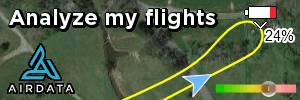I'm trying to understand the limits of the FAA's authority over private property.
You are using an out of date browser. It may not display this or other websites correctly.
You should upgrade or use an alternative browser.
You should upgrade or use an alternative browser.
Could the FAA fine me for flying my drone 1 foot off the ground in my backyard solely because it's not in "visual line of site"?
- Thread starter Dangerly
- Start date
- Status
- Not open for further replies.
The air is not your property so there is no competing space to contest. The private part is the ground and the things upon it. The FAA is not out patrolling your lawn looking for you to make a mistake. They are simply doing what they can to provide a safe environment for air travel. That includes everything from commercial aircraft to drones that have the ability to interfere with the flight of a maned aircraft. If you start a hover and go inside where you cannot see your drone you are breaking the visual line of site rule but very doubtful anyone is going to be knocking on your door.
You are asking about a crazy contrived hypothetical situation that's never going to happen.I'm trying to understand the limits of the FAA's authority over private property.
Exactly. I am asking this question in order to understand what the actual law is. I was called out on this forum for flying up to tree top level beyond VLOS on my own property and I'm wondering at what point it's really an issue.You are asking about a crazy contrived hypothetical situation that's never going to happen.
Rchawks
Well-Known Member
What the FAA is others are worried about is people flying above 400 ft and endangering other aircraft or flying over roadways and people. VLOS is a good thing and for those who fly rc that's the only thing they know. I never once took my eyes off my sailplane while flying and could always see it when it was just a speck in the sky, back in the day. With the lighthouse style of lighting there's no excuse not to be able to see it in the air and with that a very respectable range can be achieved legally according to the FAA. Also breaking any laws imposed by the FAA in case of injury to someone or property involves legal responsibility for your actions. Not preaching only exposing the risk of mishap.
Cobra193
Well-Known Member
height is irrelevant to BVLOS. You could be 6 inches off the ground, if you can’t see your drone with unaided eye, you’re flying BVLOS.
The point is (and this happens all the time), what if you’re automated systems and video feed fails? How would you fly it home or land, or even know you’re 6 inches off the ground, or 400ft?
The point is (and this happens all the time), what if you’re automated systems and video feed fails? How would you fly it home or land, or even know you’re 6 inches off the ground, or 400ft?
No - that's quite clearly not what you are doing. If that were the case you would simply have asked for an explanation of the application of the law. What you are doing is creating an absurd scenario to attempt to argue that the law is flawed.Exactly. I am asking this question in order to understand what the actual law is.
Do you understand why the VLOS requirement is in place? Have you read the numerous posts on this forum where pilots lost control of their UAV, nearby but out of VLOS, and subsequently crashed or lost the aircraft due to being unable to pilot it visually? How about you apply just a little critical thinking and try to answer your own question before going straight to a slippery slope fallacy.I was called out on this forum for flying up to tree top level beyond VLOS on my own property and I'm wondering at what point it's really an issue.
What the FAA is others are worried about is people flying above 400 ft and endangering other aircraft or flying over roadways and people. VLOS is a good thing and for those who fly rc that's the only thing they know. I never once took my eyes off my sailplane while flying and could always see it when it was just a speck in the sky, back in the day. With the lighthouse style of lighting there's no excuse not to be able to see it in the air and with that a very respectable range can be achieved legally according to the FAA. Also breaking any laws imposed by the FAA in case of injury to someone or property involves legal responsibility for your actions. Not preaching only exposing the risk of mishap.
I've not read the numerous posts on this forum where pilots lost control nearby but out of VLOS. If I had, perhaps I would not have asked the question. Since I've not read these posts, perhaps someone could explain a scenario to me, where I'm a foot off the ground in clear airspace on my own property with no structures or people around for miles, within a few hundred feet. of the RC, and then I end up causing harm to someone or something. That's really my question.No - that's quite clearly not what you are doing. If that were the case you would simply have asked for an explanation of the application of the law. What you are doing is creating an absurd scenario to attempt to argue that the law is flawed.
Do you understand why the VLOS requirement is in place? Have you read the numerous posts on this forum where pilots lost control of their UAV, nearby but out of VLOS, and subsequently crashed or lost the aircraft due to being unable to pilot it visually? How about you apply just a little critical thinking and try to answer your own question before going straight to a slippery slope fallacy.
Exactly. I am asking this question in order to understand what the actual law is. I was called out on this forum for flying up to tree top level beyond VLOS on my own property and I'm wondering at what point it's really an issue.
The point it becomes an issue is when something goes wrong and you either cause harm to a third party's person or property, or you break the rules in a sufficiently egregious way to a third party that they get some kind of authorities or legal representation involved, e.g. file a civil suit. "Authorities" here includes regulatory bodies like the FAA/CAA/EASA and police, but also things like local councils, home owner associations and the like - anyone that even *thinks* they can set rules (even if they can't) that may constrain your ability to take off and fly. Theoretically, and while highly unlikely, either of those could happen during your backyard BVLOS flight if you get a flyaway or something happens that results in an out of control LiPo fire.
The two rules that matter are that you are responsible for the safety of your flight and that you are responsible for complying with any local restrictions placed upon your flight. Should the worst happen, then you can expect the prosecution to try and find any breach of the regulations, any safety check failure, or any operational failure, no matter how minor, that you have made to help make their case.
Pretty much any scenario here is going to start with a flyaway, because at that point all bets are off - the drone may climb, just keep going, start flying in circles, manouevre apparently at random, or some combination of the above. YDroneMV. Eventually, if you can't regain control, the drone will come down or hit something. That has a non-zero potential for starting a battery fire, which in turn has a non-zero potential for starting a larger fire. In some locations that could be a serious problem, and if the fire is downwind of the crashsite enabling the debris to be recovered and tied back to you, then you can absolutely guarantee it's going to become a serious problem for you as well.I've not read the numerous posts on this forum where pilots lost control nearby but out of VLOS. If I had, perhaps I would not have asked the question. Since I've not read these posts, perhaps someone could explain a scenario to me, where I'm a foot off the ground in clear airspace on my own property with no structures or people around for miles, within a few hundred feet. of the RC, and then I end up causing harm to someone or something. That's really my question.
Yes, that's pretty extreme and even more unlikely, but flyaways can happen to anyone, often without warning, and regardless of range or the state of VLOS . If the worst does happen, then everything and anything you can say or show to demonstrate your flight was safe and legal will help you and/or support any insurance claims. This is why people flying drones commercially will often keep logs, record preflight checklists, and so on and, while that level of detail may be overkill for recreational flights, being able to show that you are in the habit of doing preflights and operating legally certainly isn't going to hurt if things ever do go sideways.
Hope for the best, but assume the worst.
D
Deleted member 103366
Guest
Can a modern DJI drone so low? I suspect you would have to disable the landing protection, if possible, to be able to do so.
Then there is the consideration, if something does go wrong, what is the minimum RTH height? I recollect 15m it the Fly app.
Then there is the consideration, if something does go wrong, what is the minimum RTH height? I recollect 15m it the Fly app.
Last edited by a moderator:
Are you serious!I'm trying to understand the limits of the FAA's authority over private property.
tlswift58
Well-Known Member
Plain and simple. If YOU are not watching your drone, say a neighbor or kid down the street comes into your yard and sees a cool drone hovering - then goes to check it out (you know kids like to touch things) and for a HYPOTHETICAL thingy, you move the drone (sticks) or a gust of wind comes and blows the drone into said person causing serious damage - yes drone props can and will due such things.I've not read the numerous posts on this forum where pilots lost control nearby but out of VLOS. If I had, perhaps I would not have asked the question. Since I've not read these posts, perhaps someone could explain a scenario to me, where I'm a foot off the ground in clear airspace on my own property with no structures or people around for miles, within a few hundred feet. of the RC, and then I end up causing harm to someone or something. That's really my question.
That's YOUR hypothetical damage scenario and when those said neighbors sue you for every cent you have - then you'll understand VLOS / BVLOS. Then I'm sure the FAA will notice and may want to speak with you as well.
tlswift58
Well-Known Member
Yes, going above 400 ft does create some issues - yet as has been posted here in last couple of weeks - manned aircraft can / do fly BELOW the 600 ft ceiling many of us believed was their threshold. I'm sure 600 ft is a good thing - yet many manned aircraft regularly do fly below 600 ft.What the FAA is others are worried about is people flying above 400 ft and endangering other aircraft or flying over roadways and people. VLOS is a good thing and for those who fly rc that's the only thing they know. I never once took my eyes off my sailplane while flying and could always see it when it was just a speck in the sky, back in the day. With the lighthouse style of lighting there's no excuse not to be able to see it in the air and with that a very respectable range can be achieved legally according to the FAA. Also breaking any laws imposed by the FAA in case of injury to someone or property involves legal responsibility for your actions. Not preaching only exposing the risk of mishap.
I'd suspect the FAA and everyone else is more worried about those who have a need to see if DJI or any other drone manufacturers range claims are true. Even those whom say they can fly 1 mile while maintaining VLOS are suspect at best. Even with aids like strobes, on a bright sunny cloudless day - seeing a drone at even 300-400 ft AGL and 1/2+ mile out is stretching the boundaries and everyone knows it. Yet, I'd say 99.999% of us have flown BVLOS at least once or twice in our flying lifetime. Hard not to in many cases, esp for those of us who don't live a flatlander (for miles) life and have such things as trees, mountains, and other naturally occurring things that can and do block VLOS. Add in buildings and other man made things that can and do block LOS - it happens.
It's those that regularly fly way beyond and then have issues that creates the issues. We read on the forum almost every day a pilot losing a drone - by either not being aware of wind speeds and flying too far and can't make it back home due low battery, birds, and simple drone failure (it is a man made imperfect machine). That's when bad things can happen. And when bad does happen - guess who suffers the resulting negative press and insane rules that local to federal governments tend to enact.
The Point beyond VLOS is the issue.Exactly. I am asking this question in order to understand what the actual law is. I was called out on this forum for flying up to tree top level beyond VLOS on my own property and I'm wondering at what point it's really an issue.
Your question seems quite simple to me and to others that have answered your question. It is simply this: when the drone is in the air, 6 in or 400 ft, systems beyond your control can fail and it has the “possibility” of flying away on its own to wherever, into a nearby person, a neighbor’s house, or a manned aircraft. If you have visual line of sight, you “may” have the ability to immediately interact and make changes in its flight pattern. If you do not have visual line of sight, then you may not have that possibility to interact simply looking through the camera alone. Again this can happen if it’s 6 inches off the ground or 400 feet up; you need visual line of sight so that you can take immediate action. I hope this breaks it down clear enough for you got understand. Be safe and happy flying.I've not read the numerous posts on this forum where pilots lost control nearby but out of VLOS. If I had, perhaps I would not have asked the question. Since I've not read these posts, perhaps someone could explain a scenario to me, where I'm a foot off the ground in clear airspace on my own property with no structures or people around for miles, within a few hundred feet. of the RC, and then I end up causing harm to someone or something. That's really my question.
Just want to say I can definitely see my drone at about 2,100'. No way anyone could see their drone at one mile.Yes, going above 400 ft does create some issues - yet as has been posted here in last couple of weeks - manned aircraft can / do fly BELOW the 600 ft ceiling many of us believed was their threshold. I'm sure 600 ft is a good thing - yet many manned aircraft regularly do fly below 600 ft.
I'd suspect the FAA and everyone else is more worried about those who have a need to see if DJI or any other drone manufacturers range claims are true. Even those whom say they can fly 1 mile while maintaining VLOS are suspect at best. Even with aids like strobes, on a bright sunny cloudless day - seeing a drone at even 300-400 ft AGL and 1/2+ mile out is stretching the boundaries and everyone knows it. Yet, I'd say 99.999% of us have flown BVLOS at least once or twice in our flying lifetime. Hard not to in many cases, esp for those of us who don't live a flatlander (for miles) life and have such things as trees, mountains, and other naturally occurring things that can and do block VLOS. Add in buildings and other man made things that can and do block LOS - it happens.
It's those that regularly fly way beyond and then have issues that creates the issues. We read on the forum almost every day a pilot losing a drone - by either not being aware of wind speeds and flying too far and can't make it back home due low battery, birds, and simple drone failure (it is a man made imperfect machine). That's when bad things can happen. And when bad does happen - guess who suffers the resulting negative press and insane rules that local to federal governments tend to enact.
Chaosrider
Well-Known Member
It does happen, but not all the time.height is irrelevant to BVLOS. You could be 6 inches off the ground, if you can’t see your drone with unaided eye, you’re flying BVLOS.
The point is (and this happens all the time), what if you’re automated systems and video feed fails? How would you fly it home or land, or even know you’re 6 inches off the ground, or 400ft?
But that raises an interesting question: Is there any QUANTITATIVE data on the rate of video feed failures? I've never had one, but I haven't been flying that long.
Thx,
TCS
hiflyer201
Well-Known Member
- Joined
- Sep 27, 2018
- Messages
- 2,740
- Reactions
- 2,167
D
Deleted member 103366
Guest
Do drones record such an event in either flight log?interesting question: Is there any QUANTITATIVE data on the rate of video feed failures?
I am working on (modifying someone else's program) a 'pilot's log book' which is a summary of each and every flight for which I have usable flight logs. It uses DOS and Linux programming to select data from chosen columns of the csv's of the .txt flight logs, it's quite interesting to see what you can pick out and 'calculate'.
- Status
- Not open for further replies.
Similar threads
- Replies
- 27
- Views
- 6K
- Replies
- 6
- Views
- 1K
- Replies
- 16
- Views
- 3K
- Replies
- 18
- Views
- 7K
DJI Drone Deals
New Threads
-
-
-
Avatar: Fire and Ash Drone Light Show.
- Started by The Droning Company
- Replies: 0
-
Globalstar and Skydio Trial Validates D2D for Drones.
- Started by The Droning Company
- Replies: 0
-










